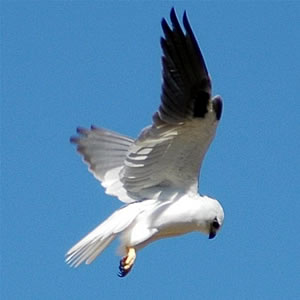|
| 질의: european rabbit | 결과: 42번째/49 | |
Black-shouldered Kite (Elanus axillaris) - Wiki
| 제목: | Black-shouldered Kite (Elanus axillaris) - Wiki
| |

| 해상도: 300x300
파일크기: 12008 Bytes
등록시간: 2007:10:22 10:44:00
|
Black-shouldered Kite
From Wikipedia, the free encyclopedia
[Photo] Black-shouldered Kite (Elanus axillaris). Date 2005. Author Brett Donald.
The Black-shouldered Kite (Elanus axillaris) is a small raptor found in open habitat throughout Australia. Like all the elanid kites, it is a specialist predator of rodents.
Name
The name "Black-shouldered Kite" was formerly used for a European and African species, Elanus caeruleus, and the Australian bird (and also a North American species, the White-tailed Kite Elanus leucurus) were treated as subspecies of this. However the three species are now regarded as distinct, and the name Black-winged Kite is used for E. caeruleus. Modern references to the Black-shouldered Kite should therefore unambiguously mean the Australian species.
Appearance
Black-Shouldered Kites are around 35 to 38 cm in length and have a wingspan of between 80 and 95 cm. Adults are a very pale grey with a white head and white underparts. The leading edge of the inner wing is black. When perched, this gives them their prominent black "shoulders".
Range
Although reported from almost all parts of Australia, they are most common in the relatively fertile south-east and south-west corners of the mainland, and in south-east Queensland.They are also common throughout Southern Africa. They are rare in the deep desert and appear to be only accidental visitors to northern Tasmania and the Torres Strait islands. Although found in timbered country, they are mainly birds of the grasslands. European occupation of Australia has, on the whole, benefited them by clearing vast expanses of forest for agriculture and providing suitable conditions for much larger numbers of mice.
Food and hunting
Black-shouldered Kites live almost exclusively on mice. They take other suitably-sized creatures when available, including grasshoppers, rats, small reptiles, birds, and even (very rarely) rabbits, but mice and other mouse-sized mammals account for over 90% of their diet. Their influence on mouse populations is probably significant: adults take two or three mice a day each if they can, and on one occasion a male was observed bringing no less than 14 mice to a nest of well-advanced fledglings within an hour.
Like other elanid kites, Black-shouldered Kites hunt by quartering grasslands for small creatures. This can be from a perch (usually a dead tree, as illustrated above), but more often by hovering in mid-air with conspicuous skill and little apparent effort. Typically, a kite will hover 10 to 50 metres above a particular spot, peering down intently, sometimes for only a few seconds, often for a minute or more, then glide swiftly to a new vantage point and hover again.
When a mouse or other prey is spotted, the kite drops silently onto it, feet-first with wings raised high; sometimes in one long drop to ground level, more often in two or more stages, with hovering pauses at intermediate heights. About two-thirds of attacks are successful. Prey can either be eaten in flight or carried back to a perch.
http://en.wikipedia.org/wiki/Black-shouldered_Kite
| The text in this page is based on the copyrighted Wikipedia article shown in above URL. It is used under the GNU Free Documentation License. You may redistribute it, verbatim or modified, providing that you comply with the terms of the GFDL. |
|
^o^
동물그림창고 똑똑전화 누리집
^o^
|
|